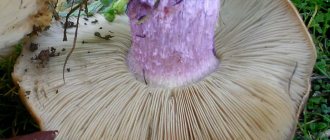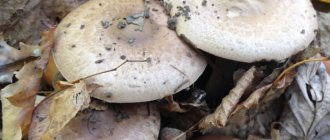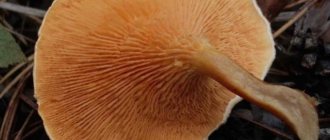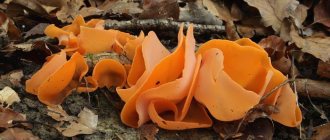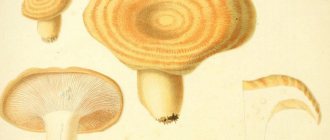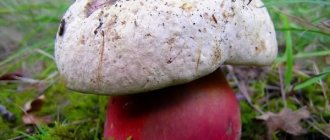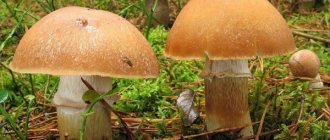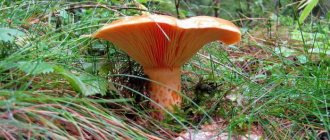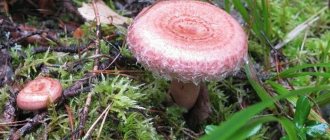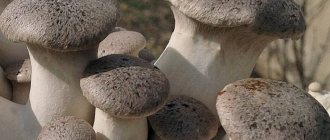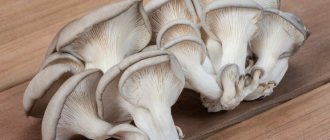Description of the mushroom
Orange tremella, Tremella mesenterica or Draglia (Tremella mesenterica in Latin) very much resembles jelly or a beard of a reddish hue, but is definitely not a mushroom.
In dry times, the orange tremors dry out and look like a crust that has stuck to the substrate. After a sufficient amount of moisture appears, the body swells and returns to its original appearance. When the weather is too humid, this mushroom becomes white and transparent. Old specimens dry out, turn black, and their surface becomes rougher.
hat
The cap, or fruiting body, has a jelly-like shape. At first it is brain-shaped, and when it grows, folds appear on it. The surface of the shaker is sticky. The size of this mushroom can be from one to ten centimeters. In nature, yellow, pale yellow, and orange tremella are found, and sometimes transparent bodies are also found.
Hymenophore
The lower part of the cap is not visible due to its bizarre and unusual shape.
Pulp
The pulp of yellow or ordinary tremors resembles jelly in shape. But despite this, it is quite strong. In appearance, the pulp is jelly-like, but when it dries, it becomes harder. It has no taste or smell as such.
Leg
This type of mushroom does not have a stalk.
Medicinal properties of orange tremors
Orange tremors have the following medicinal and healing properties.
- Wound healing.
- Immunomodulatory.
- Hemostatic.
- Antitumor.
The mushroom has not been studied thoroughly, which means that there is a high probability that the tremors contain many other useful properties and qualities that we do not yet know about.
Important! In recent years, Tremella mesenterica has been shown to help relieve inflammation and also have a positive effect on preventing allergic reactions. This mushroom ideally fights diabetes.
The product helps well with paralysis, as well as with sexual diseases.
Time and place of fruiting
This mushroom can very often be found in our country both in forests and on plains. It is a parasite, which means it lives on other fungal hosts growing on old rotten trees.
Usually these are deciduous trees, for example, hazel and birch, less often coniferous. The easiest time to find these mushrooms is when it is lightly drizzling. If the conditions for growth and development are favorable, then the tremors bear fruit well.
The growing season is at the end of summer, August. The mushroom bears fruit until the end of autumn, i.e. in November. It happens to notice tremors in winter, but at this time it freezes, and when the cold season ends, it continues to grow and develop.
Effect on the body
The narcotic effect of psilocybin is associated with its effect on serotonin receptors. In the body, as a result of a series of biochemical reactions, this substance is converted into psilocin, which is similar in chemical structure to endogenous serotonin, therefore it not only imitates, but also greatly enhances its effect by binding to specific neuroreceptors. It is because of this narcotic effect that the distribution of psilocybin mushrooms is prohibited in many countries.
The results of functional magnetic resonance imaging of the brain indicate the following effects of the psychedelic:
- increased activity in areas that regulate the perception of visual and other sensory information;
- stimulation of areas of the brain that are normally activated only during dreams and are associated with the emotional sphere;
- acceleration of the relationship between various parts of the central nervous system;
- increased activity of the amygdala, which causes emotional lability.
Consequences of use
Initially, there was an opinion among “consumers” that such drugs were quite safe and much harmless than LSD and ecstasy, but clinical studies have demonstrated that regular use, and even more so episodes of overdose of psilocybin mushrooms, cause various changes in internal organs. There is a high probability of circulatory disorders and intracellular dystrophy. Psilocybin has negative effects on the heart, kidneys and liver.
False doubles
Due to its rather unusual appearance, the trembler will not be easily confused with another mushroom. But in the Drozhalkov family, all specimens are a little similar.
For example, there is the leafy tremblor, which is inedible and at the same time looks like its orange namesake. They differ only in their color.
Trembling foliage
There is another look-alike species - the fuchsoid tremors, but it is easy to distinguish by color. The double is white, but the orange Trembling, which is discussed in the article, is red (this is clear from the name). The difference with other “brothers” can be easily seen by looking at the photographs.
Fuchsoid tremors
Growth time
The orange quail season begins in August and continues until the end of autumn. Sometimes it occurs in winter. In places with a mild climate, orange tremors can even bear fruit, and quite abundantly, throughout the mushroom season, all year round.
It is interesting that in winter the orange trembler freezes, and during the thaw it continues to develop further. A bright yellow mushroom dusted with snow looks very impressive.
Preparation
The tremors can be eaten. It is eaten boiled and added to various salads as a decoration. You can also make a very healthy broth from these mushrooms.
In China, tremors are considered a delicacy and are highly prized. The Chinese prepare soups for vegetarians and add various ingredients to the dishes.
Cleaning
After you have collected the tremella, it must be processed correctly:
- Rinse under running water.
- Pry the skin with a knife and remove.
- Rinse thoroughly again.
Cooking
The main thing you need to know is that orange tremors need additional preparation before use. The mushrooms must be boiled, and the duration of the process depends on the cooking method. On average, it will take you about half an hour.
Pickling
This mushroom is useful in any form, and pickled tremella are also very tasty. They can be eaten as an independent snack or served as a side dish.
For this you will need:
- mushrooms – 2 kg;
- seasoning for Korean carrots – 20-30 grams;
- salt – 1 tbsp. l.;
- sugar – 0.5 tbsp. l.;
- garlic -2 cloves;
- black and white pepper – 1 tsp each.
Step-by-step preparation
- Take the required amount of dried or fresh mushrooms and soak in water. If they are completely dry, then for 2 hours.
- Add seasonings, salt, sugar, garlic, pepper.
- All ingredients must be mixed thoroughly so that the spices are distributed evenly.
- After this, the resulting mixture is placed in glass jars and the lids are tightly screwed on.
Freezing
Washed mushrooms must be prepared for freezing:
- Clean them from damaged parts.
- Soak for ten minutes in water and then drain in a colander.
- After the water has drained, place the shakers on a dry towel to let the excess moisture drain away.
- After that, distribute them into plastic containers or bags and put them in the freezer.
Frying
What to do:
- Take dry mushrooms and place them in water for half an hour.
- After this time, drain the water and place in a colander. Please note - they should double in size.
- Cut into arbitrary pieces.
- After this, place the mushrooms in a preheated frying pan with vegetable oil and lightly fry. You can add soy sauce to taste.
- Serve any salad, porridge or potatoes as a side dish.
Pickling
For salting you will need:
- Boil the fungi for 15 minutes in salted water (half a tablespoon per liter of water).
- Divide into jars.
- Pour in brine with seasonings, you can add citric acid.
- Tighten the jars and put them in a warm place, covered with a blanket.
- After they have cooled completely, you need to put them in a cool place.
Drying
Well washed and peeled mushrooms must be dried. To do this, use an oven or special drying cabinets. Here's what to do:
- Peel the mushrooms and wipe with a napkin.
- Cut large specimens into pieces.
- Place on a wire rack and place in the oven for approximately 3 hours (temperature - 60 degrees).
Tremella membranous tincture
Ingredients:
- 1 kg of mushrooms;
- 200 ml of vodka or alcohol.
Step-by-step preparation
- Place the peeled tremella in a jar.
- Fill with vodka or alcohol.
- Place in a dark, dry place for 20-25 days.
The tincture can be used for external use, as it has an anti-inflammatory effect.
Soup recipe
Ingredients:
- 100 grams of dried shake;
- 1 handful of lotus seeds;
- 10 pieces. red dates;
- 1 Chinese pear (can be replaced with a regular one);
- a handful of goji berries.
Step-by-step preparation
- Take dried mushrooms and place them in water for about twenty minutes.
- After this, drain in a colander.
- Sort through and remove all damaged areas, chop into small pieces.
- Place in a saucepan and fill with clean water.
- Put it on gas. Add lotus seeds, chopped pear and dates.
- Finally add goji berries. If necessary, you can season with sugar to taste.
The total cooking time for this soup will be approximately one hour. An indicator of readiness will be the growth of the mushroom by four times.
In addition, it should lose its color. According to Chinese doctors, eating soup will give you strength and energy and increase your immunity.
Medicinal properties
Drozhalka is valued by Russians, residents of the CIS, representatives of European countries and the United States not only for its edible properties, but also for its medicinal properties. This mushroom contains a very useful substance, a biologically active polysaccharide. It is glucuronoxylomannan
.
Scientists studied this polysaccharide for a very long time before coming to the following conclusions. It has a number of health benefits and functions. For example, it stimulates the immune system, has a radioprotective function, anti-inflammatory and antidiabetic effect, and also has anti-allergenic activity. Also, this particular fungus may be involved in protecting the liver from such a serious disease as hepatitis B.
In addition, the mushroom contains a pronounced ethanol extract. It is found mainly in fresh fruiting bodies, but disappears in dried ones. It affects the growth of cancer cells. If you start taking the mushroom in the early stages of the disease, death can be avoided. This means that it prevents lung cancer, as well as such a serious disease as cervical cancer.
Ethanol extract increases the production of interferon in the body, improves immunity, and enhances the effect of chemotherapy.
Article on the topic - Mushroom Trametes variegated (Trameta) or Tinder fungus variegated: a medicinal mushroom of the 22nd century.
In China, based on orange tremors, several good and effective medications have already been produced, tested and officially patented, the main focus of which is anti-inflammatory and antitumor effects. Also, drugs that contain ingredients from tremors help regulate blood pressure inside the body.
The fruiting bodies of the tremors themselves contain amino acids, which are indispensable for the proper functioning of the body. It also contains B vitamins.
It turns out that the mushroom is a very valuable medicine and is worth eating, if only to fill your body with useful substances.
In order to produce mushrooms for medicinal purposes, China specifically uses the deep method. Since ancient times, this mushroom has been used as a restorative and restorative remedy; mushrooms were eaten raw, made into porridge, dried and made into powder. They showed themselves excellently in the fight against pulmonary diseases, paralysis, and bronchitis.
Drops from tremors effectively prevented the development of eye inflammation and also acted as a sedative.
Tremors were used for treatment not only in Asian countries, but also in England. For example, freshly picked, moist fruiting bodies were rubbed onto damaged areas where tissue tears had formed. Thus, they prevented the development of diseases and showed a healing effect. Also, trembling showed itself well in the fight against ulcers that occur on the skin.
The mushroom was also widely used in the Balkans. For example, in Bulgaria there is one proven folk recipe that is still used today.
- You need to take from 6 to 10 g of dried shake.
- Add 30 to 50 g of fresh mushrooms.
- All this must be filled with cold water and put on fire.
- Cook the mixture over low heat until the mushrooms and water turn into sour cream or become like a paste.
- At the end of cooking, you need to add one new spoon of honey to the resulting liquid.
This decoction must be drunk before bedtime, and the treatment period is from 7 to 10 days. This remedy quickly helps with pneumonia, bronchitis, colds, asthma, flu, ARVI and other undesirable manifestations.
Video gallery
Video reviews
A selection of videos with descriptions and recipes for preparing mushrooms
about Mushrooms and Plants in Your Own Words, Mushroom Experts of the Russian Federation TV, Sergey Zhigalov
Interesting Facts
In Europe, they believe that if a tremors grow near the door of a house, then the owner has been damaged. To get rid of it, you need to pierce the mushroom with a pin. It is important that the juice flows out onto the ground.
A very long time ago, glue was prepared from tremors, but only a few people knew how it was done and therefore, unfortunately, the recipe has been lost to date.
Orange tremors are a very interesting mushroom, as evidenced by its location and unusual appearance. If you see tremella in the forest, do not pass by, collect it and actively use it in nutrition and treatment.
Notes
- ↑ 1 2 3 Chen CJ.
Morphological and molecular studies in the genus
Tremella
. - Berlin: J. Cramer, 1998. - P. 225. - ISBN 3-443-59076-4. - Roberts P, de Meijer AAR. (1997). “Macromycetes from the state of Paraná, Brazil. 6. Sirobasidiaceae & Tremellaceae.” Mycotaxon
.
64
: 261–283. - Hsieh, Huei-Mei; Ju, Yu-Ming; Rogers, Jack D. (July–August 2005). Natvig, Don, ed. “Molecular phylogeny of Hypoxylon and closely related genera.” Mycologia
.
Lawrence, Kansas, USA: The Mycological Society of America. 97
(4): 844–865. DOI:10.3852/mycologia.97.4.844. ISSN 1557-2536. PMID 16457354. Print ISSN: 0027-5514. Retrieved 31 January 2012. - Lowy B.
Flora Neotropica 6: Tremellales. - New York: Hafner, 1971. - ISBN 0-89327-220-5. - Australian Fungi Checklist アーカイブされたコピー. Retrieved June 10, 2010. Archived March 18, 2011.
- New Zealand Fungi Checklist https://nzfungi.landcareresearch.co.nz/html/data.asp?ID=&NAMEPKey=11470
- Olive LS. (1958). “The lower Basidiomycetes of Tahiti (continued).” Bulletin of the Torrey Botanical Club
.
85
(2): 89–110. DOI:10.2307/2483023. JSTOR 2483023. - Hemmes DE, Desjardin DE.
Mushrooms of Hawai'i: an identification guide. - Ten Speed Press, 2002. - ISBN 1-58008-339-0.
Use in cosmetology
Cosmetologists include practical use among its beneficial properties and use it as a product that moisturizes the skin and can make it soft and elastic.
Natural polysaccharides easily penetrate into the deep layers of the epidermis and have a rejuvenating effect from the inside, retaining moisture in the cells.
Irina Selyutina (Biologist):
The acidic polysaccharide extracted from the fruiting bodies of tremella is similar in its physical and chemical characteristics to hyaluronic acid. Its excellent moisturizing effect, as well as its high ability to retain water, were extremely highly appreciated by manufacturers of detox products for regular use in urban conditions and dry air environments.
Tremella fucus has the only strict contraindication – individual hypersensitivity to this product. Tremella is included in anti-age and anti-stress products for the skin, and now also in protective products for hair. The optimal working concentration of the component in the finished product is considered to be in the range of 0.02-0.5%.
Tremella extract used in cosmetology is stored exclusively in powder form.
Geography of distribution
The geography of distribution covers those areas where the fungus on which Tremella parasitizes grows - this is Archer's annulogipoxylon (saprotrophic mushroom) or it will be old fallen branches and trunks of dead large-leaved trees, more often - the common Indian mango. Grows singly or in small colonies.
Natural habitat includes tropical and subtropical regions including Asian countries, the Australian continent, Central America, the Pacific Islands and New Zealand.
Tremella fuciformis is grown artificially for culinary purposes.
Wheatgrass infusion
- method No. 1
One tablespoon of wheatgrass is poured into one glass of boiling water and left for 30 minutes. Take the prepared infusion depending on the disease:
- for male infertility, one tablespoon 3 times a day;
- for gout, osteochondrosis, arthritis, the infusion should stand all night, then take half a glass 3 times a day;
- for radiation sickness, infuse in a thermos for 8 hours and take half a glass 3 times.
- method No. 2
Add 4 tablespoons of dry wheatgrass rhizomes to one glass of cold boiling water and leave for 12 hours. Then the mixture is filtered, and the remaining rhizomes are poured with another glass of hot boiling water and infused for an hour. The second infusion is also filtered and mixed with the first. Take the resulting infusion depending on the ailment:
- for gastritis, colitis, enteritis, metabolic disorders, 4 times a day, half a glass;
- for aching joints and rheumatism, 2 to 4 times a day, 1/3 cup;
- for cholelithiasis, drink in equal portions throughout the day.
- method No. 3
For 20 grams of plant rhizomes, take 1.5 cups of hot boiling water and leave for about several hours. The strained infusion is taken for cholecystitis 3 times a day, one glass (course 1 month).
- method No. 4
When washing out excess salt from the joints, infuse one glass of rhizomes in 1 liter of water for 12 hours. You can add honey to the strained infusion and drink half a glass 3-5 times a day.
- method No. 5
Add 15g of dry wheatgrass rhizomes to 2 cups of cold boiled water and leave for 12 hours. The strained solution is used depending on the disease:
- for coughs (colds and inflammation of the upper respiratory tract), urate and oxolate stones 3 times a day, half a glass;
- for rickets, diathesis (including exudative) 3 times a day, two tablespoons.
Practical use
The mushroom is used in cooking and cosmetology
Industrial cultivation of this species in China began in the 19th century. Traditional Chinese soup and drinks are prepared from tremella; it is an ingredient in sweet desserts, including ice cream.
Benefits of mushroom:
- increases immunity;
- increases the body's resistance to radiation, accelerates recovery processes, shortening the rehabilitation period after chemotherapy;
- normalizes the functioning of the respiratory system;
- stabilizes the activity of the heart and blood vessels, improves the functioning of the hematopoietic organs, strengthening micromuscular tone, preventing cholesterol deposits on the walls of blood vessels;
- prevents the development of thrombolebitis and varicose veins, harmonizes blood clotting processes;
- prevents increases in blood sugar levels;
- acts as an anti-allergenic agent;
- improves the functioning of internal organs, including the spleen, gastrointestinal tract, stimulating the outflow of bile and increasing the speed of intestinal motility.
In cosmetology, mushroom pulp is a remedy for wrinkles; it is used in the form of anti-aging masks and as part of decorative cosmetics.
Contraindications
Tremella fucus can harm the health of young children under 3 years of age and pregnant and lactating women.
It is not recommended to use it simultaneously with medications that reduce blood clotting (anticoagulants).
Ice mushroom - Tremellodon gelatinous - Pseudohydnum gelatinosum
The most powerful medicine for the most serious diseases - coral mushroom grows in our forests.
Woody Korean white mushroom
Life cycle
Trembling Orange
has a yeast-like phase in its life cycle that results from budding from basidiospores.
Alternation between asexual and sexual propagation is achieved by mating yeast-form haploid cells of two compatible mating types. Each mating type secretes a mating pheromone, which causes sexual differentiation of the target cell having the opposite mating type to the pheromone-producing cell. Sexual differentiation is characterized by arrest of growth in the G1 phase from the cell division cycle and subsequent formation of an elongated mating tube. The formation of the mating tube, initiated by pheromones A-10 and A-13, is similar to the process of bud formation during bipolar budding in yeast. Tremerogen A-10 was purified and its chemical structure was determined to be an S
-poly isoprenyl peptide. Fruiting bodies arise from a primordium located under the bark of a tree, and sometimes more than one fruiting body may arise separately from the same primordia.
What can be confused with
Despite its bright color, orange tremor is safe for humans, so it is easily used for cooking or in treating problems. However, there are false doubles, the consumption or preparation of which can lead to serious problems, including poisoning and causing significant harm to the body.
Given the specific external color of the mushroom, it will be quite difficult to confuse it with other mushrooms. However, it is worth considering that in the trembling family there are specimens that very much resemble their orange counterpart.
Have you heard about this mushroom?
Yes 16.67%
No 75%
Saw it, but didn't know what it was called 8.33%
Voted: 12
Let's turn to the leaf shaker. This mushroom is inedible, however, in its external structure and placement, this mushroom very much reminds us of yellow brain.
However, a significant difference appears in color. Leaf shake is more of a dark orange or pale red hue. But inexperienced mushroom pickers still think that this is an orange trembler and pick it. Such a mushroom cannot cause poisoning, but it has very mediocre taste properties and will simply ruin a couple of dishes for you.
Another species that can be confused with the orange tremble is the fucus trembler. True, it is easy to distinguish by color. The fucus-shaped tremors are almost transparent, with a white undertone, as if the cloudy liquid had turned into jelly and temporarily froze in a strange shape.
However, some mushroom pickers are sure that this is nothing more than an albino from the orange tremors and continue to pick these mushrooms and put them in their basket. Meanwhile, the fucus trembler is also an inedible mushroom that actively absorbs negative substances and can lead to poisoning.
It is necessary to take the issue of collecting such mushrooms very seriously.

